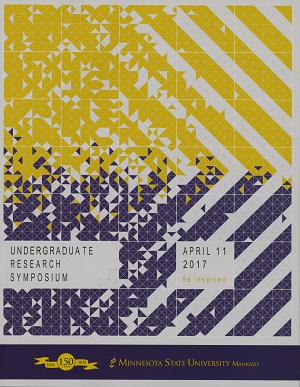Examining the Aqueous Outflow in c57BL6 Mouse Eyes Using Scanning Electron Microscopy
Location
CSU Ballroom
Start Date
11-4-2017 10:00 AM
End Date
11-4-2017 11:30 AM
Student's Major
Biological Sciences
Student's College
Science, Engineering and Technology
Mentor's Name
Michael Bentley
Mentor's Department
Biological Sciences
Mentor's College
Science, Engineering and Technology
Description
In the human eye, the aqueous fluid, which is a complex mixture of electrolytes, growth factors, and other proteins that nourish the non-vascularized tissue of the anterior chamber, is secreted by the ciliary body into the posterior chamber of the eye and then flows into the anterior chamber. The aqueous fluid flows out from the anterior chamber, through a trabecular meshwork into the Schlemm's canal at the junction of the iris and cornea, and then into the venous system of the eye. Obstruction of the outflow causes a pressure increase in the anterior chamber, which then exerts pressure on the posterior chamber, retina and the optic nerve. The resultant damage to the retina and optic nerve tissue from elevated intraocular pressure is called glaucoma. In this study, the aqueous outflow pathway in mice is examined using scanning electron microscopy. This allows us to examine the anatomy of the structures such as Schlemm's canal, collector channels and aqueous veins. C57BL6 mice, weighing around 30g were used. Mice were euthanized by CO2 inhalation. Both eyes from each mouse were removed, fixed and stored by immersion in 3% glutaraldehyde. The eye tissue were dehydrated, dried and examined. Schlemm's canal in the mouse eye will be much smaller in scale in comparison to the human eye. Examining the anatomy of the Schlemm's canal allows us to get a better understanding of the aqueous outflow and glaucoma.
Examining the Aqueous Outflow in c57BL6 Mouse Eyes Using Scanning Electron Microscopy
CSU Ballroom
In the human eye, the aqueous fluid, which is a complex mixture of electrolytes, growth factors, and other proteins that nourish the non-vascularized tissue of the anterior chamber, is secreted by the ciliary body into the posterior chamber of the eye and then flows into the anterior chamber. The aqueous fluid flows out from the anterior chamber, through a trabecular meshwork into the Schlemm's canal at the junction of the iris and cornea, and then into the venous system of the eye. Obstruction of the outflow causes a pressure increase in the anterior chamber, which then exerts pressure on the posterior chamber, retina and the optic nerve. The resultant damage to the retina and optic nerve tissue from elevated intraocular pressure is called glaucoma. In this study, the aqueous outflow pathway in mice is examined using scanning electron microscopy. This allows us to examine the anatomy of the structures such as Schlemm's canal, collector channels and aqueous veins. C57BL6 mice, weighing around 30g were used. Mice were euthanized by CO2 inhalation. Both eyes from each mouse were removed, fixed and stored by immersion in 3% glutaraldehyde. The eye tissue were dehydrated, dried and examined. Schlemm's canal in the mouse eye will be much smaller in scale in comparison to the human eye. Examining the anatomy of the Schlemm's canal allows us to get a better understanding of the aqueous outflow and glaucoma.
Recommended Citation
Achchi, Prathibha Bamunu. "Examining the Aqueous Outflow in c57BL6 Mouse Eyes Using Scanning Electron Microscopy." Undergraduate Research Symposium, Mankato, MN, April 11, 2017.
https://cornerstone.lib.mnsu.edu/urs/2017/poster-session-A/3



